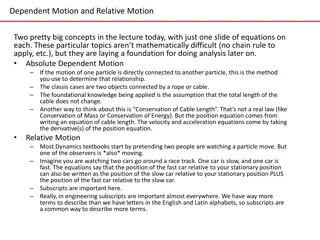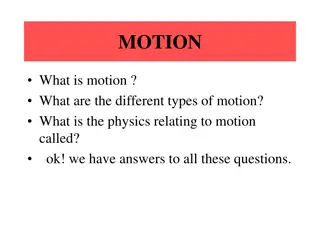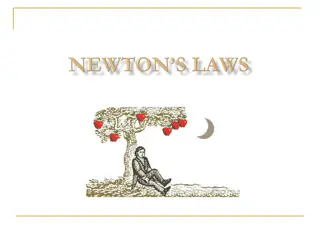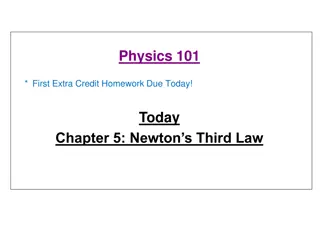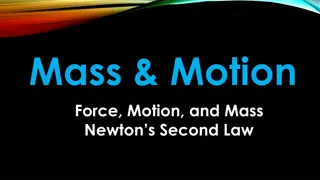Understanding Newton's Third Law of Motion
The Third Law of Motion states that for every action, there is an equal and opposite reaction. This law is demonstrated through various examples in everyday life, such as pushing against a wall, jumping on a trampoline, or how rockets work. Momentum, the product of an object's mass and velocity, plays a crucial role in determining the force needed to change an object's motion. By exploring these principles, we gain a deeper insight into the fundamental laws governing motion and forces.
Download Presentation

Please find below an Image/Link to download the presentation.
The content on the website is provided AS IS for your information and personal use only. It may not be sold, licensed, or shared on other websites without obtaining consent from the author. Download presentation by click this link. If you encounter any issues during the download, it is possible that the publisher has removed the file from their server.
E N D
Presentation Transcript
Chapter 4 The Laws of Motion The Third Law of Motion
The Third Law of Motion What happens if you push against a sturdy wall? But what happens if you pushed against that same wall while you were wearing roller skates? What would happen if you pushed even harder?
The Third Law of Motion The backwards movement that resulted from pushing on the wall is because of Newton s third law of motion When one object exerts a force on a second object, the second object exerts a force on the first that is equal in strength and opposite in direction In other words, for every action/force, there is an equal and opposite reaction/force
What do these pictures have to do with the 3rd Law of Motion?
The Third Law of Motion Action and Reaction When a force is applied, a reaction happens at the same time Example: when you jump on a trampoline, you are exerting a downward force on it. At the same time, the trampoline is exerting an equal force in the oppose/upward direction on you, so you are being sent high in to the air
The Third Law of Motion This is how rockets work In the engine, burning fuel produces hot gases The rocket engine exerts a force on these gases and causes them to escape out the back of the rocket These gases exert a force on the rocket and push it forward/upward
The Third Law of Motion Anything that moves has a property called momentum that is related to how much force is needed to change its motion Momentum is the product of its mass and velocity and is symbolized by the letter p Units are kg x m/s Use the formula Momentum Momentum (kg x m/s) = mass (kg) x velocity (m/s) p = mv Objects with more mass and/or more velocity will have a larger momentum A ballet director assigns slow, graceful steps to larger dancers, and quick movements to smaller dancers. Why is this plan successful? (p)
The Third Law of Motion At the end of a race, a sprinter with a mass of 80 kg has a speed of 10 m/s. What is the sprinter s momentum? p = ? m = 80 kg v = 10 m/s p = mv = (80 kg)(10 m/s) = 800 kg x m/s (p)
The Third Law of Motion A baseball thrown by a pitcher has a momentum of 6.0 kg x m/s. If the baseball s mass is .15 kg, what is the baseball s speed? p = m = v = What is the mass of a person walking at a speed of .8 m/s if their momentum is 52.0 kg x m/s? p = m = v = (p)
The Third Law of Motion Law of Conservation of Momentum The momentum of an object doesn t change unless its mass, velocity, or both change However, you can transfer momentum from one object to another In this picture, the cue ball has momentum because it is moving with a certain velocity. The 8-ball is motionless. When the cue ball hits the 8-ball, it slows down and the 8-ball begins to move. The momentum the 8-ball gained is equal to the momentum the cue ball lost. We say that momentum is conserved (aka saved) This is the law of conservation of momentum












